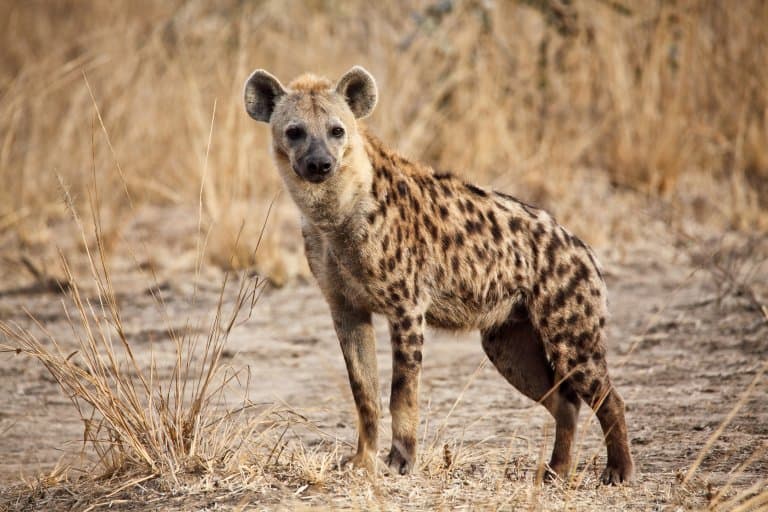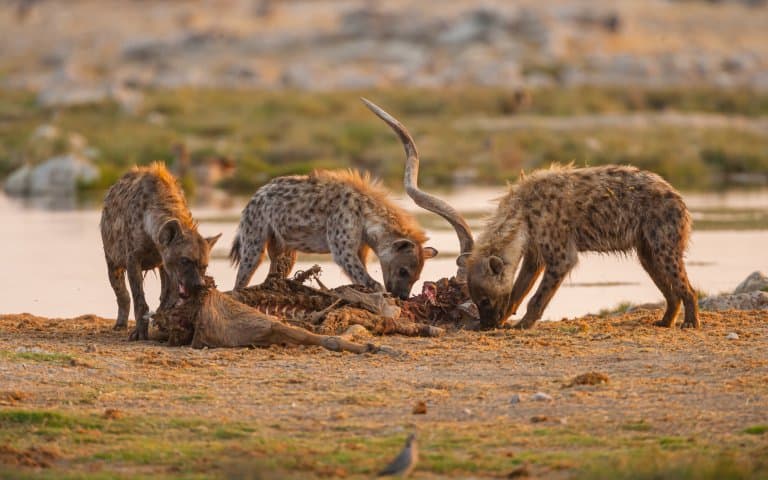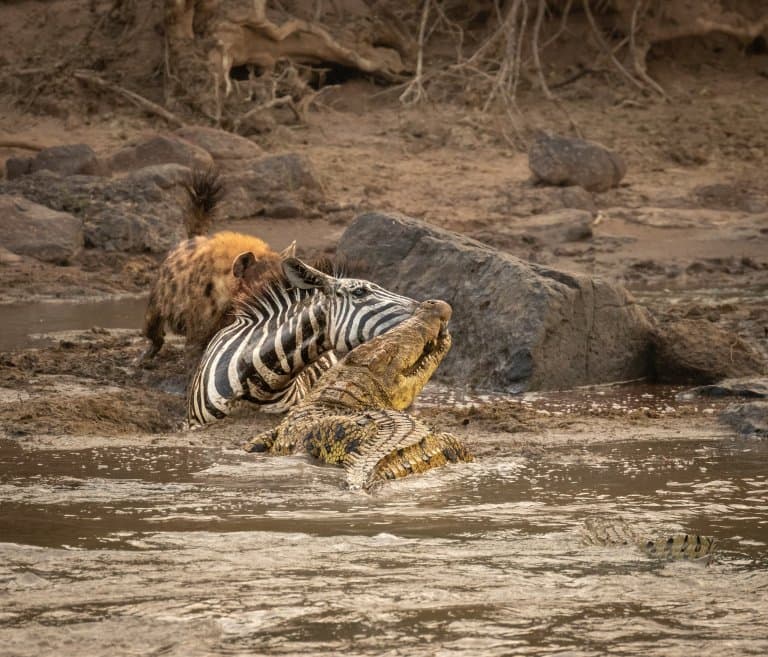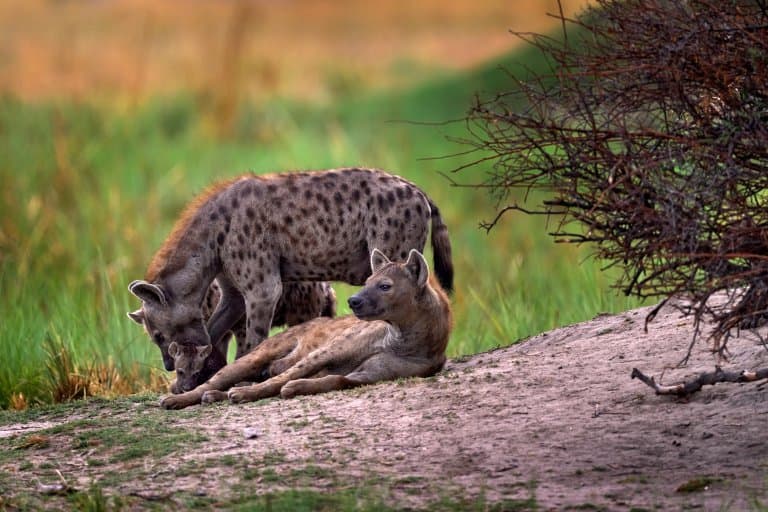Spotted Hyena Profile
It’s impossible to overstate how incredible hyenas are. Here is a mammal that survived a morphological revolution in mammalian evolution; holding onto an ancient prototype design and using it to outlast the majority of Pleistocene fauna.
Hyenas show the rest of the class of Mammalia how it’s done, and they do so with elegance and humility, despite their unfair reputation. And of the four species in the 24-million-year-old family, the spotted hyena is the most commonly encountered.
The spotted hyena, also known as the ‘laughing hyena’, is native to sub-Saharan Africa.

Spotted Hyena Facts Overview
| Habitat: | Diverse: forest, savanna, grassland, coastal, wetland |
| Location: | All over Africa |
| Lifespan: | 25 years in the wild |
| Size: | Up to 85cm (33 inches) tall, 1.5m (59 inches) long |
| Weight: | Up to 86kg (190lb) |
| Colour: | Yellow-grey coat with spots |
| Diet: | Mostly meat, carrion, sometimes vegetation |
| Predators: | None |
| Top Speed: | 60 km/h (37mph) |
| No. of Species: | 1 |
| Conservation Status: | Least Concern |
Spotted hyenas are the largest in their family, and the ones responsible for the laughing stereotype.
And laugh they should, as these are highly successful, social and intelligent animals with unique characteristics not commonly seen in modern mammals.
They are unsurprisingly named after their spotted grey-brown fur. The spots can be reddish-brown to black in color, and vary in size.
They live in communal clan dens, which have small underground tunnels. Spotted hyenas rarely dig them though, they simply take from from other animals, such as warthogs or springhares.
Unlike other hyena species, they are predators not just scavengers and will hunt for food. They will eat wildebeest, cape buffalo, zebra, Thomson’s gazelles, impala, springbok, topi and more.
The spotted hyena is classfied as least concern by the IUCN due to wide distribution and population size estimated between 27,000 and 47,000.
However, there has been a decline in numbers due to habitat loss and some poaching.
Interesting Spotted Hyena Facts
1. Spotted hyenas are the largest species of hyena
There are 4 species of hyena all from different genus – the striped hyena, the brown hyena, the spotted hyena, and the aardwolf.
Spotted hyenas are the largest living member of the Hyaenidae family. They grow up to 5 feet in length, and weigh between 90 – 140 lbs.
The aardwolf is the smallest, growing to around 2.5 feet and weighs just 17 pounds, which is smaller than most dogs.

2. They’re matriarchal
Spotted Hyena clans are made up of family groups of related hyenas, with the dominant female at the top of the rankings.
Males are the breeding currency in these social groups, and they’ll be exchanged between clans to keep the gene pool diverse.
Unlike most mammal species, females of spotted hyenas are larger than their male counterparts and have an interesting series of appendages to match. 1
3. They have a pseudopenis
This is the bane of behaviourists studying the species, as it makes the usual way of telling the sexes apart entirely redundant.
Both female and male genitalia appear very alike, as the female sports an impressive “penniform clitoris”, which hangs down much like the penis of the male. The vaginal passage has fused with the urethra inside this organ, meaning that females have to give birth through their urethral opening.
They even have a false scrotum, formed by fused labia, which is filled with fat. It’s thought that the hormones involved in maintaining the aggression and power needed for females to dominate a hyena clan result in these unusual modifications.
4. They’re scavengers
This might come as a surprise to nobody, as it’s what they’re known for, but spotted hyenas are a force to be reckoned with, and will routinely force prides of lions away from their kills.
They’re also known to eat human remains, and in more than one community across the African continent, they’re part of the human burial ritual.
These behaviours are one of the things that led to the hyena’s reputation as a cunning thief and a feeder of rotting meat. And while this evolutionary strategy is essential to the ecosystem, it’s an entirely unfair representation.

5. Spotted hyenas are also hunters
The vast majority of what we know about animal behaviour comes from what we’ve seen them do. As diurnal mammals with some of the worst night vision, this approach comes with an inherent bias, and our records are skewed by accounts that can only be created in daylight hours, using our pathetic, fleshy orbs.
But behind those orbs are (in some cases) pretty decent brains, and a handful of these brains came up with technology that can compensate for our lack of vision at night. Recent advancements in camera tech have allowed a brand-new insight into what goes on for the other half of the day while we’re asleep.
While there is indeed plenty of footage of hyenas hunting during the daytime, it seemed that they were still considered primarily as scavengers until recently.
But with the new ability to follow them at night, suddenly, the reputation of the hyena shifted from that of a lowlife scavenger into one of a tremendously organised and successful nocturnal hunter.
Now, we know that a small group of spotted hyenas can bring down a buffalo, an elephant calf, or even a fully-grown hippo. And it’s clear that while they’re perfectly happy to steal carcasses or clean up rotting cadavers, they still get the majority of their food from their own fresh kills.
6. They’ll eat anything
Hyena digestive systems are well set up to handle whatever gets sent through. The stomach can hold 14.5kg of meat in a single meal, though they’ll typically eat around 9kg a night.
And it’s not just meat; the low pH of a spotted hyena’s stomach is more than capable of dissolving bone, tendon, skin, horn, and anything else that others might leave behind.
This strong acid also allows them to safely sanitise food that’s been fermenting ripely in the savanna heat for many days.
But it’s not just the gut that’s specialised for a variety of food; the whole animal is built like a garbage disposal. 2 3

7. It’s a myth they steal from lions
Spotted hyenas and lions in particular are in direct competition, as they occupy the same geographical region and share 70% of the same diet.
While lions often ignore spotted hyenas and hyenas will generally keep their distance, they do sometimes clash.
Lions will often prevail in a fight due to their size and power, however a large hyena is dangerous to a lion – and a group of hyenas can kill a lion. For that reason, spotted hyenas are still considered apex predators, as they don’t really have any natural predators that hunt them.
One misconception is that hyenas steal kills from lions, which is a myth, and more often it’s the other way around. Lions will typically dominate over hyenas and will take hyena kills.
8. They’re bone crushers
Before the food reaches their stomach, it passes the hyena’s formidable jaws. Like cats, hyenas have shortened faces, with fewer teeth than other carnivores. The shape of the skull, the powerful muscles of the head, and the leverage and strength of the rear teeth all combine to give this animal one of the most powerful bites in the animal kingdom.
A 63kg spotted hyena is estimated to have a bite force of 565.7 newtons at the canine tip and 985.5 newtons at the carnassial. It’s jaws outmatch those of the brown bear in bone-crushing ability.
This bite makes eating bones a trivial matter, and like nutcrackers, the modified molars, called carnassials, crush hard bone to extract the marrow and grind up the rest into consumable chunks.
Interestingly, like right or left-handed people, hyenas appear to have a side preference for the teeth they’ll use for bone crushing.
Hyena dung is instantly recognisable as white droppings from the amount of calcium they consume and how efficient their nutrient absorption is.
9. They’ll even eat vegetables
Spotted hyenas are true carnivores, there’s no doubt about it. But they’re also known to supplement this meaty diet with vegetables, fruits, or human rubbish, depending on what’s available.
In one community in Ethiopia, spotted hyenas are commonly fed as valued members by the humans, who offer them bones and other meaty remains from their animals.
During periods of religious holidays, when people fast from animal products, the hyenas do just fine, getting by on leftover fruits and vegetables.
10. They’re smart!
One of the last attributes associated with hyenas is their intelligence, yet they’re one of the most cunning and communicating of all the continent’s carnivores. There’s a lot more to maintaining the social structure of a hyena clan than pure aggression; females are also incredibly diplomatic.
Spotted hyenas are the species that give the family its reputation as laughing animals. These vocalisations contain a range of information and are used to convey information in multiple contexts across both short and long distances.
At least one type of these calls, the long-distance ‘whoops’ appear to have individual identifiers, or rudimentary names, encoded in them.
This identifier can be critical if the hyena is in danger, as it can result in vast numbers of allies showing up to their aid. 4 5
11. Spotted hyenas have incredible endurance
If being smart wasn’t enough, spotted hyenas also have incredible endurance and will often run through herds of ungulates and select one individual to chase.
While they no slouch in speed, capable of running up to 60 kph (37 mph), they are able to do so over a long distance of several kilometres. Often their prey will have tired over the same distance!
They are able to do this in part due to their proportionately large heart, constituting close to 1% of its body weight. This seems to give them the edge in endurance in long chases.
12. They can be rather promiscuous
They do not form lifelong bonds and pair up, instead they will copulate with several different mates over a number of years.
Gestation tends to last just over 100 days, and the average litter consists of a couple of cubs. Males take no part in the upbringing, and females will only provide for their own cubs rather than other cubs within the group.
13. 25% of cubs are lost via siblicide
Cubs are born with 6–7 mm long canine teeth and 4 mm long incisors and will often attack each other shortly after being born.
This can often result in the death of the weaker cub, and is known as siblicide – which is common in birds and some other species.
At just 8 months old, juveniles will join the clan on hunts.

14. They have urban clans
In some parts of Africa such as the Ethiopian capital Addis Ababa, spotted hyenas have begun to visit urban areas, where clans have become a menace to locals.
Addis Ababa is estimated to have up to 1,000 resident hyenas, which mostly live by scavenging on rubbish and preying on local dogs and cats.
While typically shy towards humans, there have been reports of hyenas following locals at night and while rare, even attacks on homeless where people sleep outside.
Spotted Hyena Fact-File Summary
Scientific Classification
| Kingdom: | Animalia |
| Phylum: | Chordata |
| Class: | Mammalia |
| Order: | Carnivora |
| Family: | Hyaenidae |
| Genus: | Crocuta |
| Species: | Crocuta Crocuta |
Fact Sources & References
- “Crocuta crocuta spotted hyena”, Animal Diversity Web.
- Joh R. Henschel (2008), “How much does a spotted hyaena eat? Perspective from the Namib Desert”, Research Gate.
- “The Intestinal Eukaryotic and Bacterial Biome of Spotted Hyenas: The Impact of Social Status and Age on Diversity and Composition”, Frontiers.
- Kenna D. S. Lehmann (2022), “Long-distance vocalizations of spotted hyenas contain individual, but not group, signatures”, The Royal Society.
- Lorena Lyon (2019), “Hyenas Probably Have More Friends Than You: Spotted hyena social hierarchies”, Harward University.
